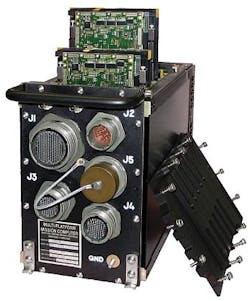Pilatus chooses 3U VPX avionics mission computer for PC-21 turboprop trainer aircraft
CHARLOTTE, N.C., 11 Jan. 2013. Avionics designers at Pilatus Aircraft Ltd. in Stans, Switzerland, needed open-architecture mission computer subsystems for the avionics suite of the Pilatus PC-21 high-performance turboprop military trainer aircraft. They found their solution from Curtiss-Wright Controls Inc. in Charlotte, N.C.
Pilatus has awarded a follow-on contract for Curtiss-Wright to provide the rugged MPMC-9350 embedded computing subsystem under terms of an $11 million contract. Shipments began last October and will continue through August 2014.
The Curtiss-Wright MPMC-9350 from Curtiss-Wright Controls Defense Solutions in Ashburn, Va., provides processing for the PC-21 pilot and co-pilot multi-function display symbology and mapping, as well as radar simulation.
The MPMC-9350 is a rugged 3U VPX avionics computer based on CompactPCI cards. The avionics computer has a five-slot forced-air enclosure that isolates its circuit cards from humidity, dust, sand, and other environmental contaminants.
The Pilatus PC-21 is a turboprop trainer that provides an unmatched level of advanced technology, configuration flexibility, and life-cycle cost savings. With an intelligent avionics system that can be modified to suit the student pilot’s phase of training, the PC-21 is significantly less costly than jet aircraft training alternatives.
The Pilatus PC-21 is a single-engine turboprop aircraft intended for primary training of future jet fighter pilots. It is a low-wing swept monoplane advanced trainer with a stepped tandem cockpit. The aircraft is similar to the Brazilian Embraer EMB 314 Super Tucano, the Korean KAI KT-1, and the Turkish TAI Hürkus.
The PC-21 has a glass cockpit with three large color liquid crystal displays (LCDs), head-up displays (HUDs), hands on throttle and stick (HOTAS) controls and zero-zero ejection seats for student and instructor.
Operators of the PC-21 include the Swiss air force, Singapore air force, United Arab Emirates air force, Royal Saudi Air Force, and Qatar Emiri Air Force
The PC-21 has the Pratt & Whitney Canada PT6A-68B turboprop engine, can fly at speeds as fast as 428 miles per hour, can fly at altitudes as high as 38,000 feet, and can simulate a variety of air-to-ground weapons.
For more information contact Curtiss-Wright Controls online at www.cwcontrols.com, Curtiss-Wright Controls Defense Solutions at www.cwcdefense.com, or Pilatus Aircraft at www.pilatus-aircraft.com.

